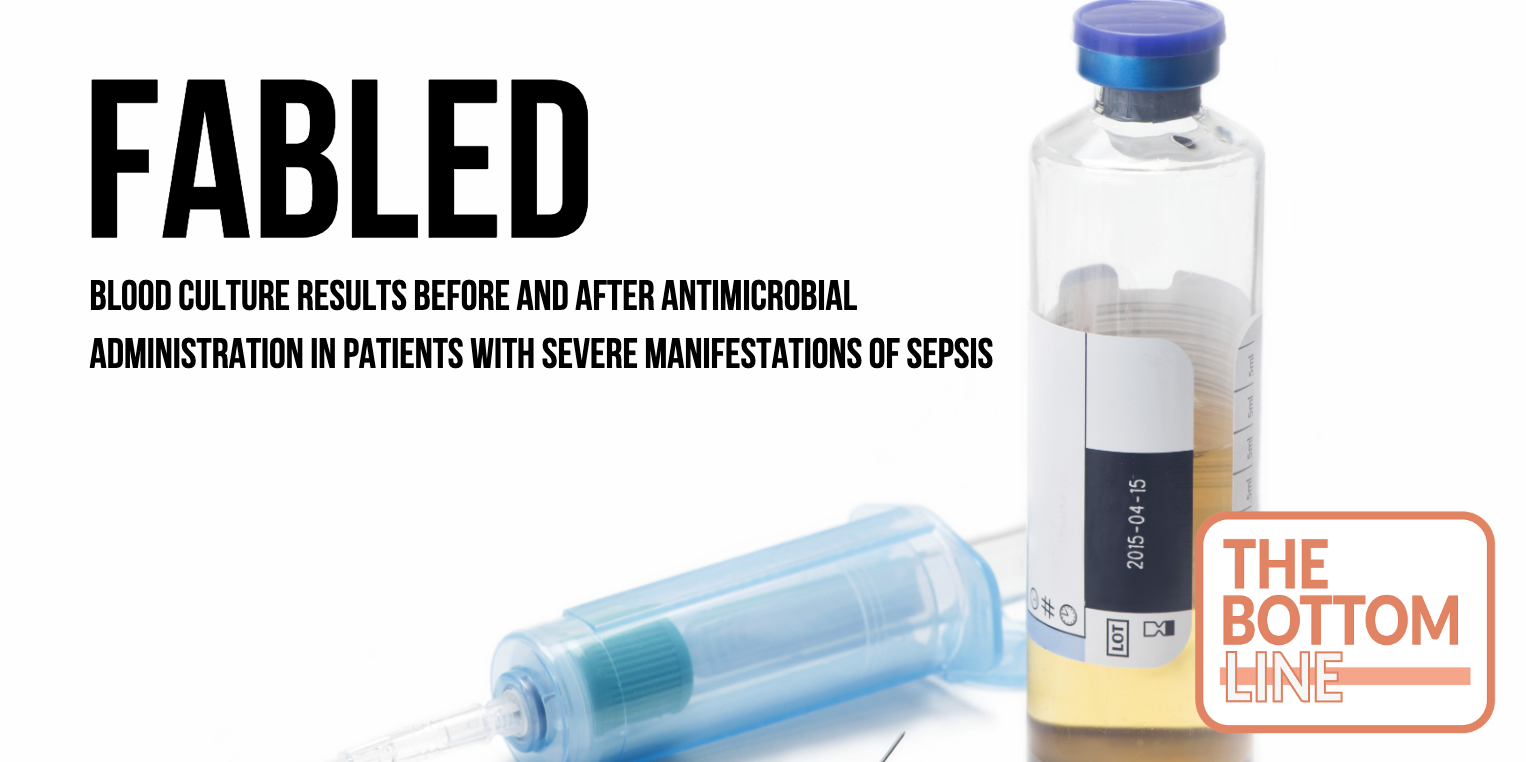FABLED

Blood Culture Results Before and After Antimicrobial Administration in Patients With Severe Manifestations of Sepsis
Cheng M, Ann Intern Med. 2019;171:547-554: doi:10.7326/M19-1696
Clinical Question
- In patients with severe sepsis what is the sensitivity of blood cultures taken after the initiation of antimicrobial therapy?
Background
- Early empiric antibiotic therapy is one of the key management goals in septic shock. Delay in first antibiotic dose is associated with a linear increase in the risk of mortality for each hour delay in antibiotic administration
- Inappropriate antibiotic choice is also associated with an increase in mortality. The mortality increases from 18 to 34% in those who have had inappropriate antibiotic selection
- Knowing the microbiological diagnoses helps clinicians tailor antimicrobial therapy
- The surviving sepsis campaign recommends taking blood cultures before starting antimicrobial therapies. However, there is a concern that waiting for blood culture collection may delay antimicrobial therapy
Design
- Patient level, single-group diagnostic cohort study
- Prospective
- Observational
- Based on previous data, 335 patients were needed assuming that 35% of patients would be bacteremic on initial cultures and that a 10% maximum difference in sensitivity between pre- and postantimicrobial blood cultures would be deemed clinically acceptable. This number was revised to 328 patients based on the repeated measures design of the study. This gave the trial 90% power
Setting
- Seven urban emergency departments across Canada and the USA
- 330 participants presenting with severe sepsis to the ER between November 2013 and September 2018
Population
- Inclusion:
- Patients 18 years of age or greater who presented to the emergency department with evidence of severe manifestations of sepsis
- This included patients that had two of the four SIRS criteria, a suspected or confirmed infection AND either an initial serum lactate ≥4mmol/L or an initial systolic blood pressure < 90mmHg.
- SIRS criteria includes
- (1) temperature >38°C or <36°C
- (2) heart rate > 90 beats per minute
- (3) respiratory rate >20 breaths per minute or PaCO2 <32 mm Hg
- (4) white blood cell count >12,000/cu mm, <4,000/cu mm, or >10% immature (band) forms
- Had 2 tests of blood cultures drawn before starting antibiotic therapy, and who were able to have additional sets drawn within 2 hours of empirical antibiotic administration
- Exclusion: Patients where excluded if they were known to have a severe coagulopathy, a platelet count below 20 000 x 109 cells/L, or an international normalized ratio above 6.0
Patient characteristics
- Mean age: 66
- Male: 63%
- Lactate >4: 62%
- BP <90: 57%
- Source of infection
- Respiratory: 33%
- Genitourinary: 18%
- Initial antimicrobial regimen
- Piperacillin-tazobactem: 34%
- Piperacillin-tazobactem + another antibiotics: 27%
- 3rd generation cephalosporin +- another antibiotic: 23.4%
- Carbapenem +- another antibiotic: 4.6%
- Repeat cultures obtained between:
- 30-120 minutes from initiation of antimicrobial therapy, n = 264 (per-protocol analysis)
- <30 minutes or >120 minutes from initiation of antimicrobial therapy, n= 61
Gold Standard Test
- Blood cultures taken before antimicrobial administration
- 2 sets of blood cultures were taken before antibiotics. Each set had 1 aerobic and 1 anaerobic bottle. Each set required a separate venepuncture
Test of Interest
- Blood cultures taken after antibiotic administration
- Protocol stipulated that cultures were to be obtained between 30-120 minutes after treatment initiation
- Protocol amended to include participants with repeated blood cultures up to 240 minutes after treatment initiation
- The results were analysed as per the a priori decision for those participants who had results taken up to 120 minutes after antimicrobial therapy. A further analysis was added to include those patients who had the second lot of cultures taken 120-240 minutes after therapy
- At 5 institutions 2 sets of cultures were taken after antibiotics and at 2 institutions 1 set of cultures were taken after antibiotics
Outcome
- Primary Outcome
- Sensitivity of blood cultures obtained within 30-120 minutes after antimicrobial therapy
- Per protocol population: 56.3% (95% C.I. 44.7% to 67.3%)
- Entire study population (included patients with cultures obtained from 0-120 minutes): 52.9% (95% C.I. 42.8%-62.9%)
- Rate of positive blood cultures in pre vs. post antimicrobial blood cultures
- Per protocol population: 30.3% vs. 19.7%, Absolute difference 10.6% (95% CI 3.3-17.9%)
- Entire study population: 31.4% vs. 19.4%, Absolute difference 12% (95% C.I. 5.4-18.6%)
- Sensitivity of blood cultures obtained within 30-120 minutes after antimicrobial therapy
- Secondary Outcomes
- If the patient had the first blood culture positive and received an antibiotic that the organism was susceptible to then the post-antimicrobial blood culture was only positive in 51.7% of cases
- If the patient had the first blood culture positive and received an antibiotic that the organism was NOT susceptible to, then the postantimicrobial culture was positive in 66.7% of cases
- If blood cultures were positive pre- and post- therapy the cultures became positive a median of 4 hours sooner after collection in the pre-therapy group
Authors’ Conclusions
- Drawing blood cultures after antimicrobial therapy in patients with severe sepsis significantly reduces the sensitivity of the blood culture
Strengths
- The trial used best practice when collecting blood culture samples pre-antimicrobial therapy, ie 2 separate sets, from 2 separate venepuncture sites. This reduced the chance of non-pathogenic contaminants
- The trial results adds weight to the recommendation that all efforts should be made to sample pre-therapy
- The contamination rate overall was 4.9% which is acceptable
Weaknesses
- The trial does not have a comparator control group, so time to antibiotic therapy is not measured and even if it was, there is no control group to determine whether taking blood cultures pre-antibiotics means there’s a delay in giving antibiotic therapy
- Only a proportion of patients screened were recruited. This limits the generalisability of these results as those that weren’t included may have had some fundamental differences from the study group
- Some variability between sites as to the method of taking the repeat blood cultures
The Bottom Line
- Positive blood cultures are far more likely to occur if cultures are drawn prior to antibiotic therapy. Logically, this is likely to help tailor antimicrobial therapy and allow de-escalation of treatment when results are obtained
- I will endeavour to take blood cultures in my patients in a timely fashion before antibiotics, providing there is no delay in giving antimicrobials
External Links
- [Abstract] Blood Culture Results Before and After Antimicrobial Administration in Patients with Severe Manifestation of Sepsis
- [further reading] Surviving Sepsis Guidelines
- [Further listening] David Sweet at Intensive Care Society, State of the Art Conference, 9-11th December 2019
Metadata
Summary author: Celia Bradford (with contribution from Hakeem Ha) @celiabradford
Summary date: February 10 2020
Peer-review editor: @davidslessor



